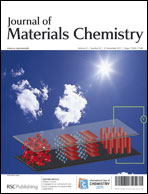Cooperative adsorbents, designed on the basis of molecular structural features of targeted pollutant, were made by simultaneous grafting of two different organic functional groups on mesoporous SiO2 material SBA-15 for removal of low concentration organic pollutants in water. In this study, eosin, 4-nonylphenol (4-NP) and di-n-butyl-phthalate (DBP) were chosen as model compounds. For molecule-specific adsorption, we synthesized three corresponding cooperative adsorbents: diamine/phenyl-SBA-15, diamine/cetyl-SBA-15 and phenyl/cetyl-SBA-15, respectively. These bifunctionalized adsorbents were prepared using two appropriate organosilanes among N-(2-aminoethyl)-3-aminopropylmethyldimethoxysilane, 3-phenoxypropyldimethylchlorosilane and n-hexadecyltriethoxysilane to modify the surface of SAB-15. The XRD, TEM, IR, N2 adsorption, 29Si MAS NMR and CHN elemental analysis measurements reveal that all cooperative adsorbents not only maintain ordered mesopores of SBA-15, but also possess characteristics of the two organic functional groups. Compared with the monofunctionalized adsorbents and their physical mixtures, the cooperative adsorbents show much higher adsorption capacity and efficiency for model pollutants at low concentration. The maximal adsorption amounts of eosin, 4-NP and DBP are 0.59, 1.49 and 1.56 mmol g−1 on corresponding cooperative adsorbents, respectively. Especially, 99.95% of eosin can be removed from low concentration aqueous solution. The experimental results confirm that the cooperative effect of two functional groups on the same solid surface leads to excellent adsorption performance of bifunctionalized adsorbents.


 Please wait while we load your content...
Please wait while we load your content...